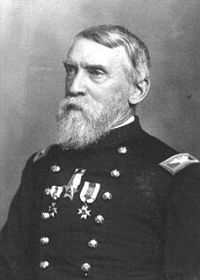- Charles Champion Gilbert
-
Charles Champion Gilbert 
Charles C. GilbertBorn March 1, 1822
Zanesville, OhioDied January 17, 1903 (aged 80)
Baltimore, MarylandPlace of burial Cave Hill Cemetery
Louisville, KentuckyAllegiance United States of America
UnionService/branch United States Army
Union ArmyYears of service 1846–86 Rank Colonel
Acting Major GeneralCommands held III Corps, Army of the Ohio Battles/wars Mexican-American War
American Civil WarCharles Champion Gilbert (March 1, 1822 – January 17, 1903) was a United States Army officer during the Mexican-American War and the American Civil War.
Contents
Early life
Gilbert was born in Zanesville, Ohio. He graduated from West Point in the famed Class of 1846, finishing 21st out of 59 students.[1] His classmates included twenty future Civil War generals, including George B. McClellan, Stonewall Jackson, George Stoneman, Darius N. Couch, and George Pickett. He served in Veracruz and Mexico City during the Mexican-American War before serving in Texas for two years. He returned to West Point in 1850 as an instructor, then served on the Western frontier. He was also the first member of the Beta Theta Pi Fraternity chapter at Ohio University (Beta Kappa).
Civil War
Early service
Shortly before the Civil War started, Gilbert was appointed captain in the 1st U.S. Infantry and commanded the post of Fort Cobb, Kansas. Once the war began, Gilbert rejoined the 1st Regiment and fought in the Battle of Wilson's Creek, where he was wounded. He was appointed inspector general in the Army of the Ohio during the Battle of Shiloh and the Siege of Corinth.
Promotion to Major General
During the Confederate Heartland Offensive, Maj. Gen. William "Bull" Nelson was wounded in the battle of Richmond and his Army of Kentucky severely mauled. Department commander, Horatio G. Wright, needed to select a replacement for the wounded Nelson and the two ranking officers, namely brigadier generals Charles Cruft and James S. Jackson, refused the promotion.[2] Therefore, at the recommendation of both Cruft and Jackson,[3] Wright promoted Captain Gilbert of the regular army to fill the vacancy. Gilbert was elevated to acting major general pending the approval of the president.[4] Several days later, on September 9, President Abraham Lincoln promoted Gilbert to brigadier general of U.S. Volunteers.[5] Wright's illegal promotion to major general, however, gave Buell enough leverage to appoint Gilbert over such generals as Jeremiah T. Boyle, Jefferson C. Davis, and Albin F. Schoepf. Buell later denied knowing Gilbert had not actually received an official appointment.[6]
Perryville
Proudly wearing two stars in his shoulders, Gilbert was temporarily placed in command of the Army of Kentucky in the absence of General Nelson. About the time Nelson was well enough to resume command, he was murdered in Louisville and Gilbert retained the command. The Army of Kentucky was assimilated into the Army of the Ohio becoming its III Corps. Maj. Gen. Don Carlos Buell, commanding the Army of the Ohio, assigned acting major general Gilbert to command the corps.[7]
A week later, Gilbert was engaged in the Battle of Perryville. His troops were successful in checking the last of the Confederate attacks and driving a Confederate brigade back through Perryville, but Gilbert was criticized for his slow action in battle and he was widely despised by the men in his corps for his actions as a martinet.[8]
Gilbert's only official appointment (to brigadier general) was not confirmed by the Senate and it expired on March 4, 1863. Some officers in the Army, including chief of staff James B. Fry, were surprised to find out Gilbert had not officially been promoted to major general.[9] Despite this he was appointed major in the 19th U.S. Infantry and brevet colonel in the regular army.
Later assignments
Maj. Gen. William S. Rosecrans took command of the Army of the Ohio and the subsequent reorganization (as the Army of the Cumberland) left Gilbert without a command. He commanded a provisional division in Tennessee at the battle of Harpeth River. The rest of his service was spent in administrative positions, holding the post of Assistant Provost Marshal General in Philadelphia, Pennsylvania and later Hartford, Connecticut, for the remainder of the war.[1]
Postbellum career
Gilbert served on the frontier until he retired in 1886. He died in Baltimore, Maryland, and was buried in Cave Hill Cemetery in Louisville, Kentucky. He was the brother of Union Brig. Gen. Samuel A. Gilbert.
See also
Notes
- ^ a b Eicher, p. 598.
- ^ Bragg's Kentucky Invasion
- ^ Official Records
- ^ Wright's Official Report
- ^ Noe, p. 84.
- ^ Noe p.97
- ^ Noe, pp. 83, 97.
- ^ Noe, p. 98.
- ^ Official Records Testimony of General Mitchell
References
- Eicher, John H., and David J. Eicher. Civil War High Commands. Stanford, CA: Stanford University Press, 2001. ISBN 0-8047-3641-3.
- Noe, Kenneth W. Perryville: This Grand Havoc of Battle. Lexington: University Press of Kentucky, 2001. ISBN 978-0-8131-2209-0.
External links
Categories:- 1822 births
- 1903 deaths
- People from Zanesville, Ohio
- American military personnel of the Mexican–American War
- Members of the Aztec Club of 1847
- Union Army generals
- United States Army generals
- United States Military Academy alumni
- People of Ohio in the American Civil War
- Burials at Cave Hill Cemetery
Wikimedia Foundation. 2010.
